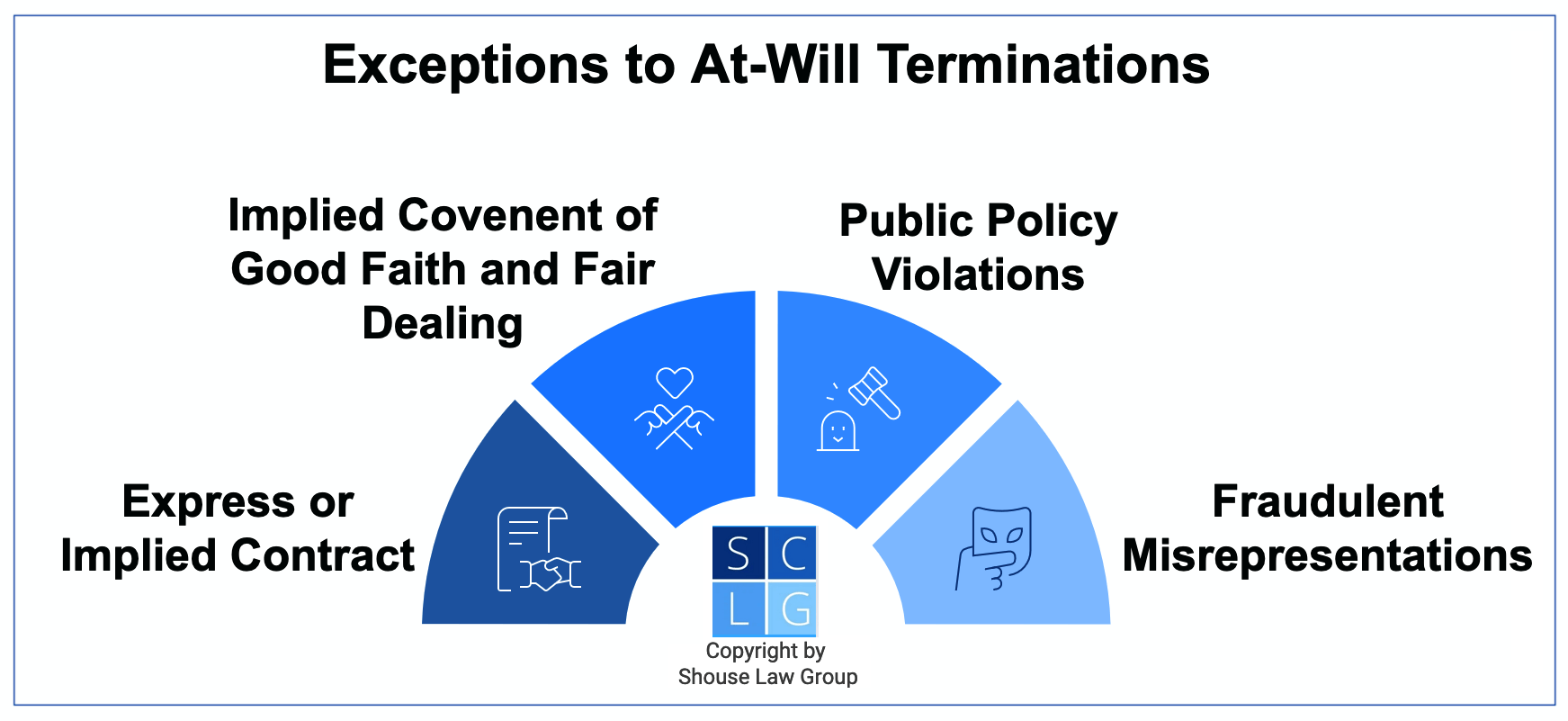California is an “at-will” employment state. This means most jobs can be terminated by the employer (as well as the employee) at any time. It is not necessary to give a reason for ending employment. 1
However, there are four exceptions that make at-will firing unlawful:
- You have an express or implied contract that prevents your employer from exercising at-will firing;
- The firing violates your employer’s implied covenant of good faith and fair dealing;
- The firing violates an important public policy; and/or
- The firing is based on fraudulent misrepresentations.

If one or more of these at-will exceptions apply to your firing, you may have grounds to sue for wrongful termination. 2
Or if you resigned because your working conditions became intolerable, you may have grounds to sue for wrongful “constructive” termination.3
Below, our California labor and employment lawyers address key issues regarding the four exceptions to the at-will employment rule.
1. Contract Exception
You and your employer may contractually agree to dispense with the at-will employment rule in California. This contract can be express (written or oral) or implied by your employer’s conduct.
In our experience, circumstances that show an implied contract exception to at-will employment include:
- Your employer’s general personnel policies and practices;
- The length of time you had worked for your employer;
- Actions or communications by your employer assuring you that you could count on continued employment; and
- Industry practices.4
The terms of implied employment contracts typically include that you cannot be fired without good cause (such as poor performance).
Example: Lily has worked as a receptionist for 10 years at a dental office with stellar reviews. The dental group’s employee handbook lists a number of reasons why employees might be terminated, including misconduct and poor job performance.
Lily gets fired with no warning, and one of the owners hires his daughter for the job. Lily may be able to sue her former employer for wrongful termination based on the implied contract exception to at-will employment.

An at-will employment contract usually makes it impossible to argue for an implied contract for continued employment.
2. Implied Covenant Exception
In California, an implied covenant of good faith and fair dealing is an unwritten promise that all parties to an express or implied contract will act in good faith and deal fairly with each other when carrying out the terms of the agreement.
This covenant can support a wrongful termination claim if your employer acted in bad faith when firing you. From what we see, this typically happens when your employer:
- Terminated you in violation of its own personnel policies,
- Terminated you to keep you from enjoying benefits to which you would have otherwise been entitled under your employment agreement (like a pension or pay already earned), and/or
- Lied about the reason you were fired.5
Example: An employment agreement provides that the employee can be terminated for poor performance of duties. Then the employee gets fired after dating the supervisor’s ex-girlfriend even though there were no negative performance reviews. The employee may have the right to sue the employer under the exception to at-will employment provided by the implied covenant of good faith and fair dealing.
Example: An employee is offered a job that requires them to quit their current job and move to a new city or state. However the employer then fires the new employee before they have had a chance to demonstrate their abilities at the new job. This could be a violation of the covenant of good faith and fair dealing.6

Unlawful reasons for employers to terminate employees include their sexual orientation, gender identity, marital status, genetic information, or national origin, affiliations, or other protected class.
3. Public Policy Exception
The public policy exception to at-will employment in California labor law allows you to sue your employer when you are fired in violation of an important public policy.
This means you have the right to bring a wrongful termination lawsuit if you are fired because you:
- Refused to violate a law,
- Performed a legal obligation,
- Exercised a legal right or privilege, or
- Reported an alleged violation of law to the government, law enforcement, or a supervisor.7
Elements of the Case
For you to win a wrongful termination lawsuit under the public policy exception to at-will employment, you would need to prove by a preponderance of the evidence the following four elements of the California jury instructions:
- The policy that you reported a violation of, or refused to violate yourself, must be set forth in a law, constitutional provision, government regulation or mandatory ethical rule;
- The policy benefited the public (as opposed to just an individual);
- The policy was fundamental and substantial; and
- The policy was well-established at the time when you were terminated.8
When the Public Policy Exception Applies
In California, many successful wrongful termination cases based on the public policy exception involved employment discrimination against protected characteristics, especially sex and disability discrimination. Other involved sexual harassment cases where employees were terminated for refusing to submit to the sexual demands of their supervisor.
Additional common bases for wrongful termination lawsuits based on the public policy exception involve retaliation for:
- Whistleblowing,
- Reporting an employer’s antitrust violations,
- Refusing to violate rules of professional conduct, and/or
- Taking job-protected leave under the California Fair Employment and Housing Act.9
Example: Armen learns that his company is paying bribes to a city council member in exchange for support for projects they are developing. Armen’s boss wants him to misrepresent these payments in the books, but Armen refuses. A week later, Armen gets laid off.
Armen may have a wrongful termination case against his employer based on the public policy exception to at-will employment.
However, the public policy exception to at-will employment does not apply when:
- The law in question is minor and not fundamental and substantial; or
- You cannot show a clear connection between your actions in support of the law or policy and your termination.10

Some employers try to masquerade unlawful firings behind California’s at-will laws.
4. Fraud Exception
In California, the fraud exception to the at-will rule usually arises in cases where your employer made specific promises to you to persuade you to take a job. However, they then violated those promises and eventually terminated you.
To win a fraud case against your employer, you need to prove by clear and convincing evidence that:
- Your employer misrepresented facts to you (either by lying outright or by concealing or failing to disclose important information);
- Your employer knew that they were making a misrepresentation;
- Your employer misrepresented facts in order to persuade you to take a particular action;
- You relied on the misrepresentations; and
- You suffered damages as a result.
You may sue your employer for damages you suffered as a result of accepting the employment in the first place. Though to get damages that arise out of the wrongful termination itself, you would need to rely on another exception to the at-will rule (such as the implied contract exception).11
Example: Andrew moves cross-country to work at Rykoff, which lies to Andrew about the company being financially stable. Then Rykoff merges with another company, eliminating Andrew’s job.
Andrew may sue the Rykoff company under the fraud exception to at-will employment. He may receive compensation for the damages he incurred by quitting his former job and moving cross-country.12

In most cases, employers do not have to give advanced notice prior to terminating employees.
Bringing a Lawsuit
Suppose you were wrongfully terminated in violation of public policy in California. In that case, the first step is often to file a complaint with the California Labor Commissioner, the California Civil Rights Department, or the federal Equal Employment Opportunity Commission (EEOC), depending on the details of your case.
Our employment law attorneys would assist in preparing your paperwork and gathering supporting evidence, such as statements from coworkers describing relevant incidents or records of correspondence with your employer. If the government agency then determines your termination was unlawful, it will grant you the right to proceed with a civil lawsuit (“notice of right to sue”).
If the lawsuit is successful, the judge may award you damages for lost income as well as emotional distress. In some cases, you can be reinstated to your job. Plus if your employer acted with malice, oppression, or fraud, the judge can even award you punitive damages.

California is an at-will employment state.
Frequently Asked Questions
How do I know if I was wrongfully terminated in California if it’s an at-will state?
Even though California is an at-will state, you may have been wrongfully terminated if one of four exceptions applies: you had a contract (written or implied) that prevented at-will firing, your employer violated good faith and fair dealing, the firing violated public policy (like retaliation for reporting illegal activity), or your employer made fraudulent promises to get you to take the job.
What counts as an implied contract that protects me from being fired without cause?
An implied contract can be shown through your employer’s personnel policies, how long you worked there, communications from your employer promising job security, and industry practices. For example, if you worked somewhere for many years with good reviews and the employee handbook lists specific reasons for termination, you may have an implied contract protecting you from being fired without good cause.
Can I sue for wrongful termination if I was fired for whistleblowing or refusing to do something illegal?
Yes, this falls under the public policy exception. You can sue if you were fired for refusing to violate a law, reporting illegal activity, exercising a legal right, or performing a legal duty. However, you must prove the policy you supported was established in law, benefited the public, was fundamental and substantial, and was well-established when you were terminated.
What should I do first if I think I was wrongfully terminated?
The first step is usually to file a complaint with the appropriate government agency – the California Labor Commissioner, California Civil Rights Department, or federal EEOC, depending on your case. An employment attorney can help prepare your paperwork and gather evidence. If the agency finds your termination was unlawful, they will give you the right to proceed with a civil lawsuit.
Additional Resources
For more information, refer to the following:
- At-Will Employment – Overview of the state law by the California Chamber of Commerce.
- At-Will Employment – Article by Workplace Fairness, a nonprofit that provides education on workers’ rights.
- California Labor Federation – Advocacy group with wrongful termination publications and resources.
- Labor Notes – News source covering worker rights issues.
- National Workrights Institute – Research organization focused on employment issues like wrongful termination.
Legal References
- Labor Code 2922 LC (All employment is presumed to be “at-will” unless you and your employer agree otherwise or an exception to at-will employment applies).
- Foley v. Interactive Data Corp. (1988) 47 Cal.3d 654.
- Turner v. Anheuser-Busch, Inc. (1994) 7 Cal.4th 1238.
- See note 2. See also, for example, Mendoza v. Trans Valley Transport (
- See Kelecheva v. Multivision Cable T.V. Corp. (1993) 18 Cal.App.4th 521. See also Guz v. Bechtel Nat. Inc. (2000) 24 Cal.4th 317.
- Sheppard v. Morgan Keegan & Co. (1990) 218 Cal.App.3d 61.
- See notes 2 & 3. See also, for example, Tevis v. Spare Time (See Labor Code 1102.5 LC.
- California Criminal Jury Instructions CACI 2430. City of Moorpark v. Superior Court (1998) 18 Cal.4th 1143
- Tameny v. Atlantic Richfield Co. (Cal. 1980) 610 P.2d 1330; Rojo v. Kliger (1990) 52 Cal. 3d 65; General Dynamics Corp. v. Superior Court (1994) 7 Cal. 4th 1164; Collier v. Superior Court (1991) 228 Cal.App.3d 1117. See note 8.
- See, for example, Silo v. CHW Med. Foundation (2002) 27 Cal. 4th 1097. See note 3.
- Lazar v. Superior Court (1996) 12 Cal.4th 631. White v. Smule, Inc. (Cal.App. 2022) 75 Cal. App. 5th 346 See note 2. See also Liodas v. Sahadi (1977) 19 Cal.3d 278 (standard of proof in fraud cases).
- Same.
